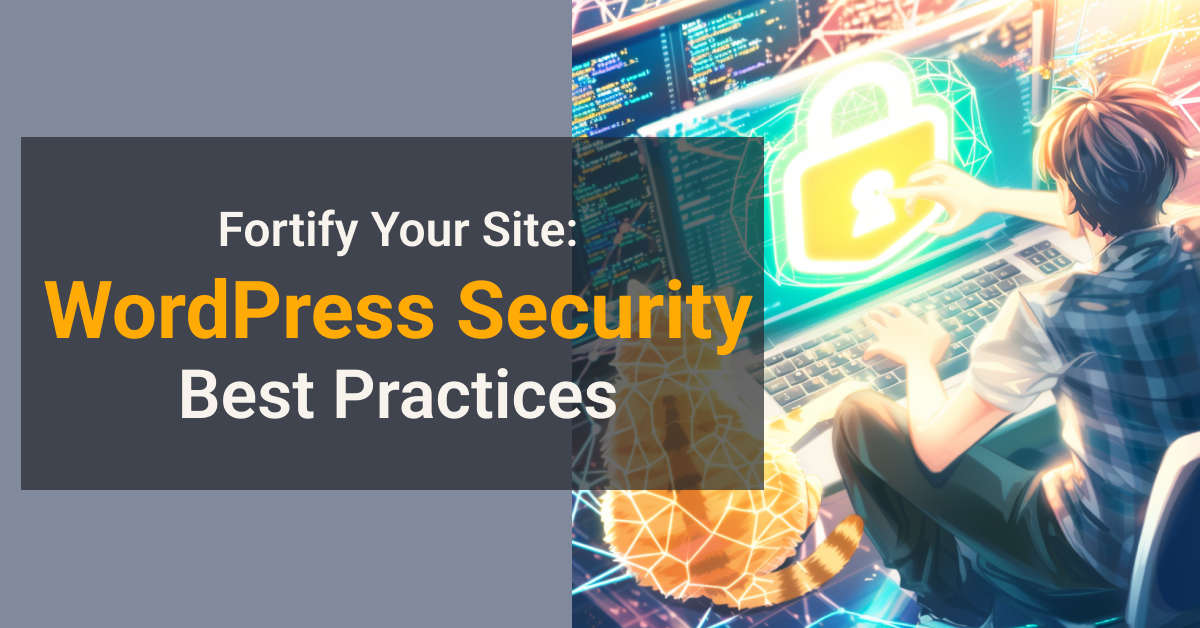Notice: Only variables should be passed by reference in /home/ploi/pryvus.com/public/wp-content/themes/pryvus/template-parts/content-post.php on line 12

Introduction to WordPress Security Best Practices
In the digital age, securing your WordPress site is not just an option; it’s a necessity. With WordPress powering over 40% of all websites, it’s a prime target for hackers and malicious actors. However, by following WordPress security best practices, you can significantly reduce the risk of your site being compromised. But what makes WordPress security so crucial, and how can you implement these best practices effectively?
“Implementing WordPress security best practices is essential for protecting your site against threats.”
WordPress security encompasses a range of practices designed to protect your website from unauthorized access, malware, and other security threats. These practices include keeping WordPress, themes, and plugins up to date, using strong passwords, and installing security plugins. Moreover, implementing security measures like two-factor authentication (2FA), secure socket layer (SSL) certificates, and regular backups can make a substantial difference in your site’s overall security posture.
The importance of WordPress security cannot be overstated. A secure WordPress site ensures the safety of your data and your users’ data, maintains your site’s integrity and reputation, and protects against potential financial losses and legal issues associated with data breaches. Additionally, search engines may penalize compromised sites, affecting your SEO efforts and visibility.
Throughout this article, we will dive deep into why WordPress security is essential, highlight the top security plugins to safeguard your site, and explore both basic and advanced security measures you can implement. Whether you’re a beginner or an experienced WordPress user, these best practices will help you fortify your site against the ever-evolving landscape of cyber threats.
Why WordPress Security is Essential for Your Site
The significance of WordPress security transcends mere precaution; it’s the foundation upon which the trust and reliability of your website are built. In an era where cyber threats are not just rampant but also increasingly sophisticated, understanding the essence of WordPress security is paramount for every site owner.

“A secure WordPress site not only protects your data but also preserves your reputation and user trust.”
Firstly, security breaches can lead to sensitive data being stolen or leaked, including personal information about your users. Such incidents not only damage your credibility but can also have legal repercussions, especially with regulations like GDPR in place. Ensuring your WordPress site is secure helps protect against data theft and complies with data protection laws.
Moreover, a compromised website can be used to distribute malware, putting your users at risk. This not only affects those who visit your site but can also lead to blacklisting by search engines, significantly reducing your traffic and SEO rankings. Recovering from such a hit to your online presence can be challenging and time-consuming.
Additionally, the downtime and loss of business resulting from a security breach can be substantial. For e-commerce sites, this means direct financial loss, not to mention the cost of recovering the site and strengthening its security post-breach. In contrast, a secure WordPress site ensures continuous operation and reliability, fostering user trust and loyalty.
Lastly, the security of your WordPress site affects its performance and speed. Sites bogged down with malicious code or backdoors tend to load slower and may face issues with functionality. Implementing security best practices keeps your site running smoothly, ensuring a better user experience.
In conclusion, WordPress security is not just about protecting against attacks; it’s about safeguarding your site’s integrity, your users’ trust, and your business’s viability. With the stakes so high, investing time and resources into securing your WordPress site is not just advisable; it’s imperative.
Top Security Plugins for WordPress Protection
One of the most straightforward steps to bolstering your WordPress site’s security is to utilize security plugins. These plugins are designed to provide comprehensive protection against a wide array of threats, automating many of the complex security measures you should be implementing. But with countless options available, which plugins stand out for their effectiveness?

“Choosing the right security plugin is crucial for robust WordPress protection against cyber threats.”
Wordfence Security is a powerhouse in WordPress security, offering a firewall, malware scan, and live traffic monitoring features. It goes beyond mere protection by actively blocking attacks and ensuring your site is always guarded against the latest threats.
Sucuri Security is another top contender, known for its security auditing, malware scanning, and security hardening. Sucuri excels in post-hack security actions, helping you recover your site if it’s compromised and safeguarding it against future attacks.
iThemes Security (formerly Better WP Security) offers over 30 ways to secure and protect your WordPress site. With features like two-factor authentication, password expiration, and database backups, it’s focused on preventing issues before they arise.
All In One WP Security & Firewall takes a user-friendly approach to WordPress security, making it accessible even for beginners. It checks for vulnerabilities and implements the latest recommended WordPress security practices and techniques.
When selecting a security plugin, consider your site’s specific needs and the plugin’s compatibility with other tools you’re using. Always keep your security plugins updated to the latest version to ensure you have the most current protections against threats.
By integrating one of these top security plugins into your WordPress site, you’re taking a significant step towards securing your online presence. Remember, while a security plugin is a critical component of your site’s security strategy, it should be part of a broader approach that includes regular updates, backups, and safe practices.
Regular Updates: The First Line of Defense Against Threats
Staying current with the latest versions of WordPress, along with your themes and plugins, is more than just beneficial for getting new features; it’s a critical security measure. Regular updates serve as the first line of defense against vulnerabilities that could be exploited by hackers.

“Keeping your WordPress site updated is a straightforward yet effective strategy for enhancing security.”
WordPress core updates often include security patches for vulnerabilities that have been discovered since the last release. By delaying these updates, you leave your site exposed to attacks that target these known issues. Automatic updates for minor releases have made this easier, but it’s still important to manually update for major releases as soon as possible.
Themes and plugins can also be sources of vulnerabilities. Developers regularly update these to fix bugs, add features, and patch security holes. Ensuring you’re using the latest versions is essential for closing these potential entry points for hackers. Use reputable sources for themes and plugins to reduce the risk of introducing vulnerabilities to your site.
However, before updating, always back up your site. Updates, while essential, can sometimes cause compatibility issues or other problems. A recent backup ensures you can restore your site’s previous state if needed.
Additionally, consider using a staging environment to test updates before applying them to your live site. This can help identify any issues in a safe environment, preventing potential downtime for your site’s visitors.
Regular updates, combined with strong passwords, security plugins, and other best practices, create a robust security posture for your WordPress site. By making updates a regular part of your site maintenance routine, you significantly reduce the risk of security breaches and ensure your site remains safe and secure.
Strong Passwords and User Permissions: Your Security Foundation
At the heart of WordPress security are two fundamental principles: using strong passwords and managing user permissions carefully. These might seem like basic measures, but they’re incredibly effective at preventing unauthorized access to your site.

“Strong passwords and strict user permissions form the bedrock of your WordPress site’s security.”
Strong passwords are your first defense against brute force attacks, where hackers attempt to guess login credentials. WordPress recommends using passwords that are long, complex, and unique for each user. Consider using password managers to generate and store secure passwords, making it easier to maintain strong security without needing to remember each password.
Managing user permissions means giving users only the access they need to perform their roles. WordPress comes with built-in user roles such as Administrator, Editor, Author, Contributor, and Subscriber, each with its own set of capabilities. Limiting the number of administrators reduces the risk of accidental or malicious changes to your site. Always review user roles and permissions, especially when users no longer need access or their role changes.
Implementing two-factor authentication (2FA) adds an extra layer of security, requiring users to provide two forms of identification before accessing the site. This could be a password plus a code sent to a mobile device, making it much harder for attackers to gain unauthorized access.
Lastly, regularly audit your users, checking for outdated accounts or accounts that should no longer have access. This routine check ensures that only current, legitimate users can access your site, further safeguarding it against potential security breaches.
By prioritizing strong passwords and careful management of user permissions, you create a solid foundation for your WordPress site’s security. These practices, though simple, play a crucial role in protecting your site from a wide range of threats.
Advanced Security Measures: Beyond the Basics
While foundational security practices like updates, strong passwords, and basic user permissions are critical, delving into advanced security measures can provide your WordPress site with an even higher level of protection. These sophisticated strategies can help shield your site from increasingly complex threats.

“Elevating your WordPress security with advanced measures can significantly deter potential threats.”
Implementing a Web Application Firewall (WAF) is one of the most effective advanced security measures. A WAF can block malicious traffic before it reaches your site, protecting against SQL injections, cross-site scripting (XSS), and other common attacks. Services like Cloudflare and Sucuri offer robust WAF solutions designed for WordPress.
Secure Socket Layer (SSL) encryption is another critical measure for securing data transfer between your site and your users. SSL encryption ensures that sensitive information, such as login credentials and personal data, is transmitted securely. Most hosting providers offer easy SSL certificate installations, often at no additional cost.
Database security is also paramount, as it’s often the target of attacks. Changing the default WordPress database prefix, restricting database user privileges, and regularly backing up your database can help protect against data breaches and loss.
File permissions and access controls on your server can prevent unauthorized access and modifications to your site’s files. Configuring the correct file permissions for your WordPress installation is crucial for maintaining a secure environment.
Lastly, regularly scanning your WordPress site for vulnerabilities and malware can help catch and mitigate potential security issues before they become serious problems. Many security plugins offer scanning capabilities, or you can use external services for more comprehensive assessments.
By implementing these advanced security measures, you can significantly enhance your WordPress site’s defense against cyber threats. Remember, security is an ongoing process that requires regular review and adjustment in response to evolving threats and new security best practices.
How to Handle a WordPress Security Breach
Despite your best efforts, there’s always a risk that your WordPress site might suffer a security breach. Knowing how to respond effectively can minimize the damage and help you recover more quickly. Here’s a step-by-step guide on handling a WordPress security breach.

“Quick and informed action is crucial in mitigating the impact of a WordPress security breach.”
First, if you suspect a breach, immediately change all passwords related to your site, including WordPress admin accounts, FTP/SFTP accounts, and your database password. Use strong, unique passwords for each account to prevent further unauthorized access.
Next, contact your hosting provider. They can provide information about the breach and assist in recovering your site. Many providers have experience dealing with such incidents and can offer valuable support and resources.
Then, restore your website from a backup. Ideally, you should restore from a backup taken before the breach occurred. However, ensure that this backup is clean and free of malware to avoid reintroducing vulnerabilities.
After restoring your site, thoroughly scan it for malware and vulnerabilities. Use security plugins or external services to identify and remove any malicious code. This step is crucial to ensure that your site is truly clean and secure.
Update all software, including WordPress, themes, and plugins, to their latest versions. This helps patch any vulnerabilities that might have been exploited in the attack.
Review user accounts and delete any that were created by the attacker. Also, review your site’s content and settings for any changes made by the attacker.
Finally, after resolving the issue, inform your users about the breach, especially if personal data may have been compromised. Transparency builds trust and shows your commitment to security.
Learning from the breach is also important. Analyze how the breach occurred and take steps to strengthen your site’s security to prevent future incidents.
Handling a WordPress security breach effectively involves prompt action, thorough cleanup, and clear communication. By following these steps, you can mitigate the damage and restore your site’s integrity and trustworthiness.
Conclusion: Maintaining Ongoing WordPress Security
Securing your WordPress site is not a one-time task but an ongoing commitment. In the ever-evolving landscape of cyber threats, maintaining vigilance and adhering to WordPress security best practices is crucial for safeguarding your site. By now, you’ve learned the importance of regular updates, strong passwords, advanced security measures, and how to handle a security breach. But how do you ensure ongoing security for your WordPress site?
“Consistent attention to security measures ensures your WordPress site remains protected against potential threats.”
Firstly, make security a part of your regular site maintenance routine. Schedule regular audits of your site’s security posture, including checking for updates, reviewing user access, and scanning for vulnerabilities. Many tools and services automate these tasks, making it easier to stay on top of security without it becoming overwhelming.
Stay informed about the latest security threats and trends in WordPress security. Following blogs, forums, and news sources dedicated to WordPress and cybersecurity can provide you with valuable insights and early warnings about new vulnerabilities.
Consider engaging professional security services or consultants to review your site’s security, especially if you’re running a large or high-traffic site. These experts can offer personalized advice and help identify potential weaknesses you might have overlooked.
Encourage a culture of security among your site’s users, especially if you manage a multi-author blog or a site with multiple admin users. Provide training or guidelines on secure practices, such as using strong passwords and recognizing phishing attempts.
Lastly, have a response plan in place for potential security incidents. Knowing who to contact, what steps to take, and how to communicate with your users in the event of a breach can significantly reduce the impact and recovery time.
By adopting a proactive and informed approach to WordPress security, you can not only protect your site but also ensure it remains a trustworthy and reliable resource for your users. Remember, a secure WordPress site is the result of continuous effort and vigilance.


